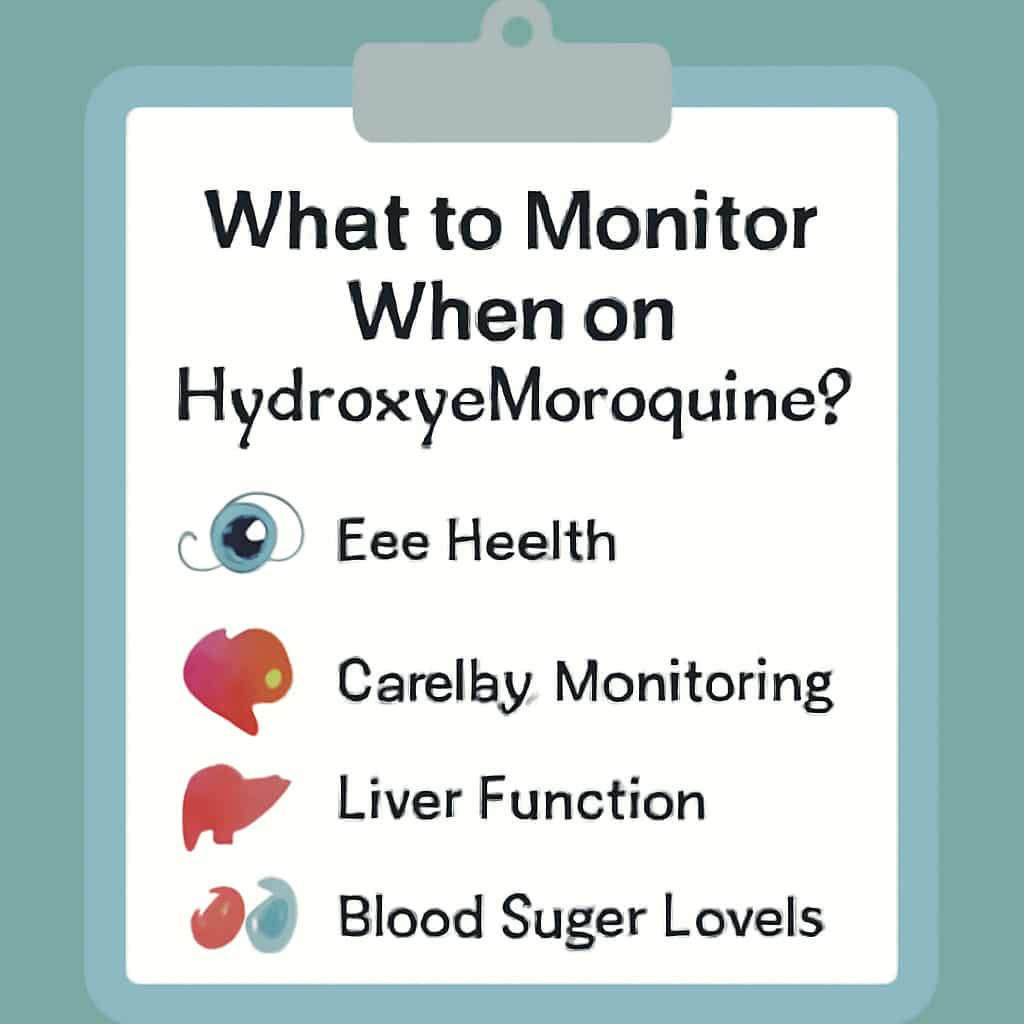
What to Monitor When on Hydroxychloroquine?
- 0
Hydroxychloroquine is a widely used medication primarily for the treatment of malaria, rheumatoid arthritis, and lupus. While it offers significant therapeutic benefits, its use requires careful monitoring due to potential side effects, especially when taken long-term. In this article, we will explore the key aspects that need to be monitored during hydroxychloroquine use to ensure the patient’s safety and well-being.
1. Eye Health: Retinopathy and Other Vision Issues
-
1.1 What is Retinopathy?
Hydroxychloroquine can affect the retina, potentially leading to a condition called retinopathy, which may cause visual disturbances and, if left unchecked, permanent damage to eyesight. -
1.2 Regular Eye Examinations:
Patients on long-term hydroxychloroquine treatment should undergo regular eye exams to monitor any changes in the retina. This is typically done through a dilated eye exam and sometimes additional imaging techniques like OCT (Optical Coherence Tomography). -
1.3 Early Symptoms to Watch For:
Patients should be aware of early warning signs like blurred vision, difficulty focusing, and other visual changes. Early detection is crucial for preventing irreversible damage.
2. Cardiac Monitoring: Potential Heart Risks
-
2.1 Cardiac Arrhythmias:
One of the less common but serious side effects of hydroxychloroquine is the risk of heart arrhythmias. These can cause abnormal heart rhythms, which may be life-threatening. -
2.2 ECG Monitoring:
For patients on long-term hydroxychloroquine therapy, periodic electrocardiograms (ECGs) are recommended to monitor for any signs of heart arrhythmias or other cardiac issues. -
2.3 Symptoms of Cardiac Issues:
Patients should report any symptoms like palpitations, chest pain, dizziness, or shortness of breath, as these could indicate heart-related problems.
3. Liver Function: Hepatotoxicity Risks
-
3.1 Hydroxychloroquine and Liver Damage:
While rare, hydroxychloroquine can cause liver toxicity, which can lead to more severe conditions like jaundice or liver failure. Monitoring liver function through regular blood tests is critical. -
3.2 Regular Blood Tests for Liver Enzymes:
Patients should undergo regular liver function tests, especially if they have pre-existing liver conditions, to ensure their liver is not being adversely affected. -
3.3 Signs of Liver Damage:
Symptoms like yellowing of the skin or eyes (jaundice), abdominal pain, and unusual fatigue could signal liver damage and should be immediately reported to a healthcare provider.
4. Kidney Function: Renal Health Monitoring
-
4.1 Kidney Toxicity and Hydroxychloroquine:
Though rare, hydroxychloroquine can cause kidney damage in some individuals, particularly if taken in high doses or for extended periods. -
4.2 Kidney Function Tests:
Regular monitoring of kidney function through blood tests for creatinine and glomerular filtration rate (GFR) is important to detect any early signs of kidney issues. -
4.3 Symptoms to Look For:
Patients should be vigilant for signs like swelling in the legs, ankles, or feet, and changes in urine output, which could indicate kidney problems.
5. Blood Sugar Levels: Hydroxychloroquine and Diabetes Risk
-
5.1 Hydroxychloroquine’s Impact on Blood Sugar:
Some studies suggest that hydroxychloroquine may influence blood sugar levels, potentially leading to an increased risk of hypoglycemia or hyperglycemia. -
5.2 Regular Blood Sugar Monitoring:
Patients with diabetes or those at risk for diabetes should regularly monitor their blood sugar levels while on hydroxychloroquine. -
5.3 Symptoms of Blood Sugar Imbalance:
Symptoms such as excessive thirst, frequent urination, unexplained weight loss, or blurred vision should be closely monitored as they could indicate blood sugar fluctuations.
6. Muscle Weakness: A Potential Side Effect
-
-
6.1 Myopathy and Hydroxychloroquine:
Hydroxychloroquine has been linked to muscle weakness and muscle pain in some patients, a condition known as myopathy.
-
-
6.2 Regular Muscle Strength Monitoring:
Patients should monitor their muscle strength and report any unusual weakness, fatigue, or pain, especially in the limbs. -
6.3 Early Detection and Prevention:
Early detection of muscle weakness allows for adjustments in dosage or alternative treatment options to prevent further deterioration.
7. Gastrointestinal Side Effects: Nausea, Vomiting, and Diarrhea
-
7.1 Hydroxychloroquine and Digestive Issues:
Common gastrointestinal side effects of hydroxychloroquine include nausea, vomiting, and diarrhea, which can affect a patient’s quality of life. -
7.2 Managing Gastrointestinal Side Effects:
It is important for patients to take hydroxychloroquine with food to minimize these effects, and any persistent symptoms should be reported to a doctor. -
7.3 Signs of Severe Reactions:
Persistent or severe gastrointestinal symptoms, such as blood in stools or vomiting, should be treated as emergencies.
8. Psychological Effects: Mood Changes and Mental Health Monitoring
-
8.1 Hydroxychloroquine and Mood Disorders:
Some patients may experience mood changes, anxiety, or depression while on hydroxychloroquine. Although rare, it is essential to monitor for any psychological symptoms. -
8.2 Regular Psychological Assessments:
Patients should be regularly assessed for any signs of mood disturbances, especially if they have a history of mental health issues. -
8.3 Support and Interventions:
If psychological side effects are detected, timely interventions like counseling or adjusting the medication may be necessary.
9. Drug Interactions: Potential Risks and Monitoring
-
-
9.1 Hydroxychloroquine and Other Medications:
Hydroxychloroquine can interact with various medications, including certain antibiotics, antifungals, and heart medications. -
9.2 Consultation with Healthcare Providers:
It is essential for patients to inform their healthcare providers of all the medications they are taking to avoid dangerous interactions.
-
-
9.3 Monitoring for Drug Interactions:
Patients should undergo regular reviews of their medication regimen to ensure that no harmful drug interactions are occurring.